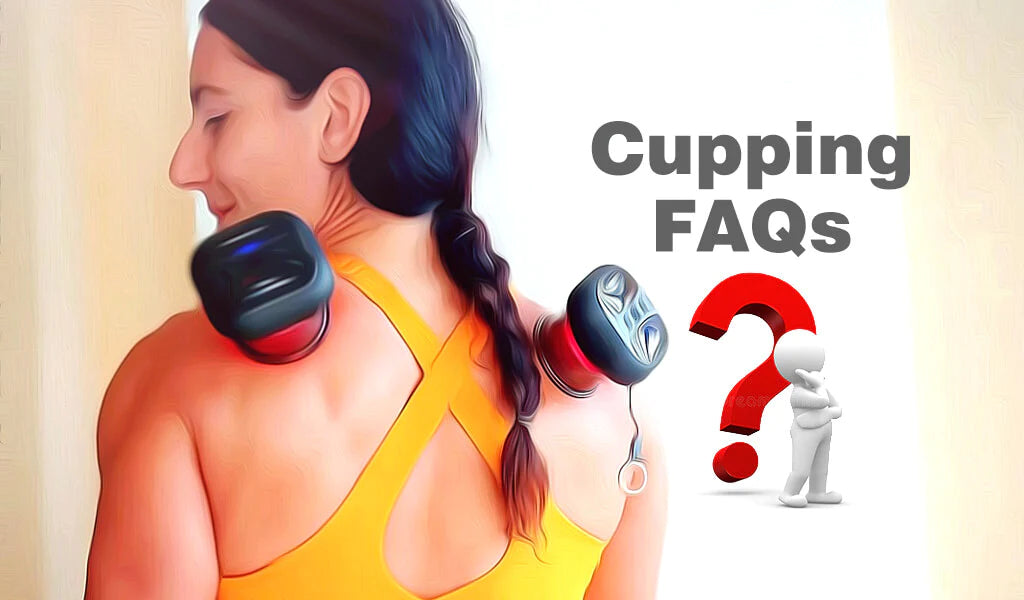
CUPPING FAQS (Find your answers here about Recoverfun Aircup)
Share

What is cupping therapy, and how does the Recoverfun Aircup work?
Cupping is a massage therapy that decompresses soft tissues using vacuum suction, unlike other massage forms that compress soft tissues. During cupping, the cup gently sucks to your skin and lifts underlying soft tissue into the cup.

The Recoverfun Aircup is unlike traditional cupping; this Recoverfun Aicup not only absorbs to lift the underlying soft tissue but also has a process of releasing and simulating the manual massage mode; its dynamic smart cupping technology and red light therapy is a game-changer in cupping Therapy which can more effectively accelerate blood circulation at the cupping area and get positive results.
How does it feel?
Cupping is very relaxing and generally not painful. The sensation experienced is a pulling of the skin as the cup is moved in a rolling fashion. It also feels like someone is giving you a spot massage on your sore muscle to relax with Recoverfun Aircup. Redness or warmth is usually experienced after the cup's release due to increased blood flow to the area.
Who can benefit and Why Athletes Prefer Cupping More?
Almost anyone can benefit from cupping. It is used to treat lack of mobility, tight muscles, scars, and many diagnoses like headaches, tendinitis, bursitis, plantar fasciitis, fibromyalgia, and the release of trigger points.

The many athletes who do choose to undergo cupping therapy will often do so before participating in their sport and after. Most have a goal of addressing specific aches and pains within their body, as they want to heal these areas as much as they possibly can before participating in their chosen sport. For athletes who have been diagnosed with a specific injury or have had to undergo a surgical process, cupping therapy can be used to help their bodies heal faster.A few specific conditions that cupping can address in athletes include plantar fasciitis, hamstring strains, sore muscles, and back pain.
Where to put the cups?
Put the cupping cups at the spot of sore muscle, but cupping shouldn't be performed over any kind of open skin or lesion. It shouldn't be done over areas of edema, large blood vessels, or varicose veins,and don't do cupping therapy at the same position repeatedly; you can wait until the bruise fades before considering it again.

How long should I leave cupping on for?
Generally speaking, the duration of cupping on one part should not exceed 15 minutes at most. Usually, 5-10 minutes is the best. You can customize the lasting time via the Recoverfun Smart App.

How often should I do cupping?
You are usually done once/twice every week or every other week. If your skin has blisters or bruises that are fading slowly, you must wait longer until it recovers. If you use the lower setting level for daily muscle massage and don't get severe bruises, you can increase the frequency appropriately when needed.
What to expect after treatment?
Mild soreness is expected from the buildup of lactic acid in the muscle tissue, but less soreness than a deep tissue massage. Bruises are to be expected and can last up to a week. Physical exertion and heat are not recommended after the treatment. Cupping leaves a mark. Depending on the strength of the vacuum, the pattern can be anywhere from light red to very dark purple. The effects are perfectly round and pretty much the size of the used cup. During upping, tiny capillaries are broken, which causes discoloration, and while this may sound like a bad thing, it’s actually what promotes the healing process.
What are the Cupping benefits?
Release scar tissue and fascial adhesions
Reduce painful trigger points
Improve circulation, blood and lymph circulation
Relieve pain
Promote mobility and range of motion
Improves mature scars
Decrease toxins
Here are some don’ts:
Cupping shouldn’t be performed over any open skin or lesion. It shouldn’t be done over areas of edema, large blood vessels, or varicose veins. It shouldn’t be performed on pregnant women. In addition, people who are easily bleeders, have any bleeding disorder, or are taking blood thinners shouldn’t be cupped.
